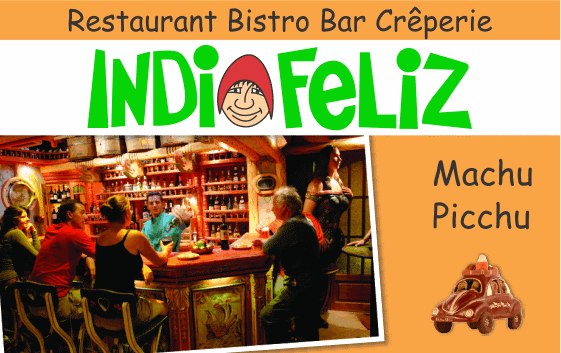PERU INFO
Home > Tourism > Places to visit > Machu Picchu
Discover Peru
Machu Picchu
Introduction
The symbol of Peru, declared a World Heritage Site by UNESCO in 1983, was voted one of the new 7 wonders of the world in 2007 after in a worldwide internet poll of 100 million people organized by the New Open World Foundation.
Machu Picchu fascinates all visitors. Located at an altitude of 2,400 m (7,872 ft) in the "ceja de selva" (high jungle) limited to the Andes, the site is a stunning, magical place.
The citadel built atop a mountain surrounded by dizzying peaks covered in a semi-tropical vegetation often shrouded in clouds that reinforce the mystery of "the lost city of the Incas" and is certainly the most beautiful manifestation of man's work in harmony with the environment.
After a century of investigations, little is known about Machu Picchu, even its original name is unknown. Thus it has been given the name of the nearest mountain which means "Old Peak" in Quechua, unlike the hill you see in classic pictures called Wayna Picchu ("Young Peak").
VISITS
The number of entries to the site is limited by Unesco and it is imperative to book in advance by choosing one of the 4 tours offered and an entry time slot.
You can view the circuit map on the official website, machupicchu.gob.pe, by clicking on INFORMACIÓN + CIRCUITOS ESTABLECIDOS.
You have the option of the visit of the site (Llaqta de Machu Picchu) or a combination with the ascent of one of the surrounding mountains:
- Circuito 4 (site visit following a pre-established circuit) + Waynapicchu
- Montaña Machupicchu + circuit 3
- Circuito 4 + Huchuypicchu.
For these combinations, the circuit must be done in the order announced. The maximum time on site will be indicated to you according to the option chosen (approximately 4/5 hours).
WARNING:
- The passport number presented at the entrance must correspond to the one communicated at the time of booking.
- To book online, enter ONLY on the official website of the Ministry of Culture:
INCA TRAIL
Access to the famous Camino Inca to reach Machu Picchu in 2 or 4 days, must be done by a sworn tourism agency.
History
There is no doubt that Machu Picchu was built during the reign of the ninth Inca Pachacutec (1438 - 1471), who developed the Tahuantinsuyo (Inca Empire). It was it a citadel, a retreat for the emperor, a religious shrine, or both? each has its version.
It is possible that Machu Picchu was a llacta, one of these agricultural, religious and military complex built in The Qapac Ñan (the Inca road system) during expansion of the empire and had the function to control and manage the new territories. It is thought that as in all llactas, they were not really cities, its population was not fixed and varies between 300 and 1,000 inhabitants, composed of elites, acclas (chosen women) and mitimaes (settlers). This could explain the abandonment of the site and forgotten for centuries. Indeed, after the conquest and decline of the Inca empire, the mitimaes mainly originate from the subject peoples could have return to their homelands.
"The discovery"
The American explorer Hiram Bingham is usually thought to be the discoverer of Machu Picchu on July 24, 1911. In fact, other people had already been before as the German engineer Augusto Berns who was looking for gold in 1867, later his compatriot Herman Göhring, followed by the Franco-Austrian Charles Wiener in 1880, the Peruvian Augustin Lizarraga in 1894 and 1902 and the English Clement Markham in 1910.
Hiram Bingham had the merit of giving the site significant publicity and fame in the world. Looking Vilcabamba, the last Inca refuge during the Spanish colonization, Bingham arrives at the foot of Machu Picchu and local farmers tell him that knew an archaeological site on the top of the mountain, inhabited by two families who farm the terraces. Although the citadel is entirely covered by the semi-tropical vegetation, Bingham was so impressed that he wrote in his diary: "Would anyone believe what I had found?"
The explorer returned the following year with several scientists under sponsorship of Yale University and National Geographic Society to clean and study Machu Picchu for three years. In return, the 46,332 archaeological artifacts found on the site go to United State. The Peruvian government has requested the return of the treasure for many years and Yale generously returned 366 pieces in May 2011 although promised to return 4,000 artifacts.
Layout
Machu Picchu is divided into an agricultural sector with numerous terraces on the slopes of the hill and an urban sector. A trench and a ladder line the wall of separation between the two sectors. The tour is done in 2 or 3 hours, it is enough to appreciate the magnificent buildings and the extraordinary landscape.
Depending on the train schedules or overnight in Aguas Calientes, there are several possibilities to complete the visit. Stroll through the llamas, enjoy the mystical atmosphere of the place and imagine being five centuries ago in the middle of the Incas, or opt for one or more of three possible hikes: Wayna Picchu, the Sun Gate and the Inca Bridge.
Wayna Picchu
It is the peak seen in classic photos (2,750 m / 9.020 ft a.s.l.). This 2 hour walk is a bit difficult and requires good physical condition with a climb of 350 meters (1,150 ft), but mostly with very carefully, the path is a bit dangerous.
From the summit a second trail leads down to the Gran Caverna on the north face of the mountain.
On the other side, you can see typical Inca constructions inside natural caves, the Temple of the Moon.
The complete circuit (Wayna Picchu and the Temple of the Moon) is done in 4 hours.
Inti Punku
Opposite Wayna Picchu, it is the arrival of the Inca Trail.
For those who have come in train, there is the option to climb this part of the Inca Trail for 1 km (0.6 mi) to the Sun Gate or Puerta del Sol (Inti Punku in Quechua). From here, the view of Machu Picchu and surrounding area is outstanding.
The walk takes less than two hours round trip, elevation of 300 m (1,000 ft).
Inca Bridge
From the top of the citadel where panoramic photos are taken, A path leads in 30 minutes to an impressive cliff where the Incas had built the road. You can not access, but from the viewpoint we have a spectacular view over the bridge in the middle of the cliff.
How to get to Machu Picchu?
TRAIN
3 starting options:
- Cusco (San Pedro station) - journey in 4 h 40
- Poroy (10 km from Cusco, access by bus or taxi) - journey in 3 h 10
- Ollantaytambo (sacred valley) - journey in 1 hour 30 minutes
2 train companies - visit the websites for timetables and prices:
Arrival at Machu Picchu Pueblo (Aguas Calientes), take a shuttle to go up to the site (30 min journey) or go up on foot (1 hour). Bus tickets on sale on site, or through the Consettur website or in Cusco av. El Sol 380 (Interbank) or av. Infancia 433 in Wanchaq (Cusco).
WALK
The famous Inca Trail is reserved for seasoned hikers and only through an authorized tourist agency.
BUS
The 3rd option is by road in 6.30 / 7 h from Cusco to Hidroelectrica, then 2 h 30 of walk to Machu Picchu Pueblo.
The easiest way is to take the service of a tourist agency.
Individually, buses leave very early from Terminal Terrestre in Cusco towards Quillambamba, get off at the village of Santa María. From here, find a bus or taxi to the village of Santa Teresa, then another transport or on foot (2 hours) to Hidroeléctrica station. From here, a single train leaves at 3:00 p.m. and reaches Aguas Calientes in 30 minutes, or on foot (2 h 30).
Aguas Calientes
From Ollantaytambo at an altitude of 2,800 m (9,200 ft), we arrived Aguas Calientes at 2,000 m (6,560 ft) a.s.l., whose official name is Macchu Picchu Pueblo. The town is obviously dedicated to tourism with many restaurants and hotels of different categories.
Buses leave from here to climb the citadel above 400 meters (1.300 ft), a distance of 8 km / 5 mi (20 minutes). First bus depart at 5:30 am.
The outdoor thermal pools can be found 15 minutes walk out of town by the main street from the main square. Open from 5:00 am to 8:00 pm - Admission: S/. 10 - US$3.
Inca Trail
The Camino Inca is one of the most popular trekking destinations in the world and is now severely regulated. The number of people is limited to 500 daily, of which only 200 are trekkers, the rest being porters, guides and cooks. Since June 2002, trekking independently on the Inca Trail is prohibited, each trekker must be accompanied by a qualified guide and make a reservation in advance.
The classic trail starts fom the Km82 in the village of Piscacucho (2,600 m / 8,530 ft a.s.l.) that can be reached from Ollantaytambo in the Sacred Valley by private bus or train. The tour takes place in 4 days and 3 nights, through 3 passes including one at 4,200 meters (13,780 ft) a.s.l., to get to Macchu Picchu in the morning of the fourth day so you have time to visit the site. Overnights in tents.
Another option is the short way, a six hours trip, getting off the train at the Km104 (6 km / 4 mi before Aguas Calientes), crossing Wiñaywayna and Inti Punku (Sun Gate).
ATTENTION !
Entrance in the Inca Trail is now limited to 500 visitors por day and it is essential to book in advance. Also, the passport number presented at the entrance of the site should be the same as that of the reservation.
ACCESS TO THE INCA TRAIL IS IMPOSSIBLE INDEPENDENTLY, YOU CAN ONLY ENTER WITH AN AUTHORIZED TOURIST AGENCY.
Tourism




